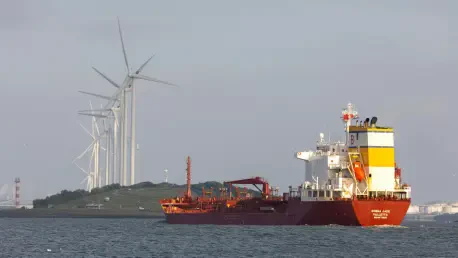Setting the Stage for Sustainable Maritime Logistics
In a world where maritime shipping accounts for nearly 3% of global CO₂ emissions, the push for decarbonization has never been more urgent, especially as supply chains stretch across oceans, carrying goods critical to economies worldwide. The environmental toll of traditional fossil fuel-based shipping looms large, making sustainable alternatives a pressing need. This analysis dives into the transformative partnership between DHL Global Forwarding and Henkel, two industry giants spearheading a shift toward sustainable marine fuel (SMF) in ocean freight. By examining their collaboration, this piece uncovers key market trends, quantifies the impact of their initiatives, and projects the ripple effects on the logistics sector. The importance of such efforts cannot be overstated as businesses grapple with tightening climate regulations and rising stakeholder expectations for greener operations.
Decoding Market Trends in Green Ocean Freight
Rising Demand for Sustainable Solutions
The maritime logistics market is undergoing a profound transformation as pressure mounts to meet global climate targets, such as the International Maritime Organization’s goal of net-zero emissions by 2050. Historically reliant on heavy bunker fuels, the industry faces scrutiny for its carbon footprint, prompting a surge in demand for alternative fuels like SMF, derived from renewable sources or waste materials. Adoption, though, remains hampered by limited supply and higher costs compared to conventional options. Despite these barriers, corporate sustainability commitments are driving investment, with companies increasingly prioritizing low-emission transport to align with consumer and regulatory demands. The DHL-Henkel partnership exemplifies this trend, showcasing a viable path to emissions reduction without sacrificing efficiency.
Quantifying Impact Through Data-Driven Initiatives
A pivotal aspect of current market dynamics is the measurable progress in emissions reduction through structured programs. DHL’s GoGreen Plus service, in collaboration with Henkel, targets a substantial volume of ocean freight—9,000 TEUs (twenty-foot equivalent units)—with an expected cut of 4,700 tonnes of CO₂e. This translates to an impressive 85% reduction on the main haul compared to traditional fuels, signaling SMF’s potential to reshape the environmental profile of shipping. Such data underscores a growing segment of the market where sustainability and operational goals converge. As more logistics providers adopt similar metrics-driven approaches, the industry could see a competitive edge emerge for early movers who invest in green technologies.
Innovative Mechanisms Shaping Adoption Rates
Beyond raw numbers, innovative systems are altering how sustainability integrates into market practices. The “Book & Claim” model, employed by DHL and Henkel, allows for the purchase of SMF to be credited as emissions reductions to clients, even if the fuel isn’t used on their specific routes. This flexibility addresses logistical constraints, enabling broader participation without requiring immediate infrastructure overhauls. Market analysis suggests that such mechanisms could accelerate SMF uptake by reducing entry barriers, though transparency in tracking remains critical to avoid perceptions of inflated environmental benefits. This approach positions the logistics sector to scale green solutions more rapidly than direct fuel mandates would allow.
Projecting the Future of Maritime Decarbonization
Scaling Sustainable Fuel Production and Access
Looking ahead, the market for sustainable marine fuel is poised for significant growth, driven by technological advancements and increasing production capacity. Projections indicate that from 2025 to 2030, SMF availability could expand as refineries pivot toward renewable feedstocks, potentially lowering costs through economies of scale. Regulatory incentives, such as carbon pricing or subsidies for green fuels, are also likely to play a role in shaping adoption curves. The DHL-Henkel initiative serves as a litmus test, demonstrating that demand exists when backed by credible frameworks. If successful, this could catalyze a broader market shift, encouraging smaller players to enter the space and diversify fuel options.
Collaborative Models as Market Catalysts
Another forecast centers on the rise of partnerships as a dominant force in transforming ocean freight. Collaborative efforts, like the one between DHL and Henkel, highlight a market trend where shared goals amplify impact beyond what individual firms could achieve. This model not only pools resources but also mitigates risks associated with high upfront costs of sustainable fuels. Analysts anticipate that by 2027, strategic alliances could account for a significant portion of decarbonization efforts, creating a networked approach to innovation. Such trends suggest that the logistics market will increasingly reward companies that prioritize collective action over isolated strategies.
Economic and Competitive Implications
The long-term outlook also points to a reshaping of competitive landscapes within maritime logistics. Firms adopting green practices early stand to gain brand equity and customer loyalty, especially as sustainability becomes a key differentiator in procurement decisions. Economic models like Book & Claim could standardize how environmental benefits are monetized, potentially creating new revenue streams for logistics providers. However, challenges persist, including the need for global alignment on standards to prevent market fragmentation. As these dynamics unfold, the market is likely to see a widening gap between leaders who innovate and laggards who resist change, with sustainability becoming a core driver of profitability.
Reflecting on Insights and Strategic Pathways
Looking back, the partnership between DHL Global Forwarding and Henkel stands as a beacon of progress in a sector long challenged by environmental concerns. Their commitment to sustainable marine fuel and innovative systems like Book & Claim offers a tangible framework that others can replicate. For businesses navigating this evolving landscape, the path forward involves several actionable steps: assessing supply chain emissions to identify high-impact areas, partnering with logistics providers offering green services, and investing in transparent reporting to build trust. Additionally, advocating for industry-wide standards helps ensure a level playing field. These strategies, inspired by the groundwork laid by industry leaders, point toward a future where sustainability and success in maritime logistics go hand in hand.









